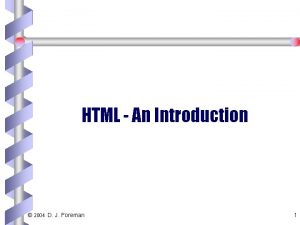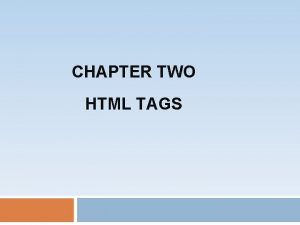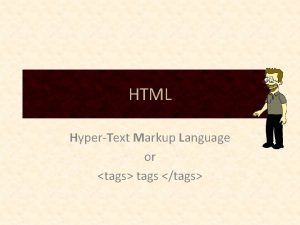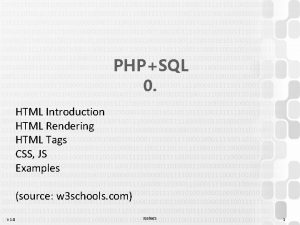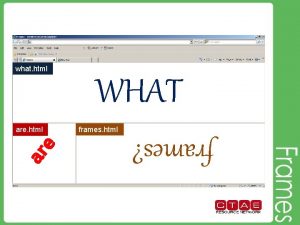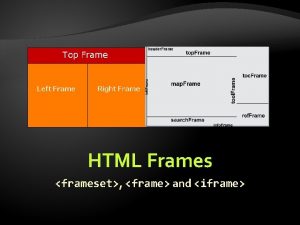FRAMES INTRODUCTION FRAMES the HTML tags that divide



















- Slides: 19

FRAMES

INTRODUCTION FRAMES: the HTML tags that divide a browser screen into two or more HTML recognizing unique regions. Tag used is the <FRAMESET>. . </FRAMESET> tags. Each unique region is called a frame. Each frame can be loaded with a different document and hence, allow multiple HTML documents to be seen concurrently.

FRAMESET tag: this tag is included after <HEAD> tag. This is a paired tag. <FRAMESET COLS=“width 1, width 2, ” ROWS=“height 1, height 2”> …. . Frame or frameset definitions…. . </FRAMESET> Cols: this attribute is used for vertical frames and widths are specified as a comma delimited list of sizes in pixels, %age, or as a proportion of the remaining space by using ‘*’. Rows: this attribute is used for horizontal frames and height again is specified in pixels , %age or as a proportion of the remaining space by using ‘*’. Attributes: Ø Border/ Frame. Border: value 0 will turn off the border and value 1 will turn it on. To increase the border width change the value of border. Ø bordercolor: to set the frame border color to a specified color.

FRAME: this tag contains the frame content. It tells the browser, what to put in each frame. Each frameset must include a <FRAME> definition for each division. It is a singular tag. Attributes: Ø Src: indicates the URL of the document to be loaded into the frame. Ø Margin. Height: specifies the amount of white space to be left at the top and bottom of the frame. Ø Margin. Width: specifies the amount of white space to be left along the sides of the frame. Ø Name: gives the frame a unique name so it can be targeted by other documents. The name given must be given with an alphanumeric character. Ø Noresize: disables the frame resizing capability. Ø Scrolling: controls the appearance of horizontal and vertical scrollbars in a frame. This takes the value YES/NO/AUTO.

<html> <head><title> FRAMING TAGS</title></head> <frameset cols="50%, 50%"> <frame src="form. html"> <frame src="1. html"> </frameset> </html>


<html> <head><title> FRAMING TAGS</title></head> <frameset cols="40%, 30%"> <frame src="form. html"> <frame src="1. html"> <frame src="table. html"> </frameset> </html>


<html> <head><title> FRAMING TAGS</title></head> <frameset rows="40%, 30%"> <frame src="form. html"> <frame src="1. html"> <frame src="table. html"> </frameset> </html>


Elastic Frames The height/ width of frames can be specified in terms of number of pixels. In elastic frames we use the notation * instead of a number. The ‘*’ means whatever is left over. <html> <head><title> FRAMING TAGS</title></head> <frameset rows="200, *, *"> <frame src="form. html"> <frame src="1. html"> <frame src="table. html"> </frameset> </html>


NESTED FRAME SETS Combinations of rows and columns <html> <head><title> FRAMING TAGS</title></head> <frameset rows="200, *, *"> <frame src="form. html"> <frameset cols="*, *"> <frame src="1. html"> <frame src="table. html"> </frameset> <frame src="form. html"> </frameset> </html>


BORDER If value id set to 0 then frame will be without border. If value is some positive number then the border size will increase as per the value. <html> <head><title> FRAMING TAGS</title></head> <frameset border=0 rows="200, *, *"> <frame src="form. html"> <frameset cols="*, *"> <frame src="1. html"> <frame src="table. html"> </frameset> <frame src="form. html"> </frameset> </html>


BORDER COLOR= purple

Frame margins : Frame tag Margin is the space between frame edge and the frame content. By default browser automatically gives each frame some empty space around its contents. It accept the value in pixels as the amount of space to be left as margins. <html> <head><title> FRAMING TAGS</title></head> <frameset border=10 bordercolor="purple" rows="200, *, *"> <frame src="form. html" marginwidth=0> <frame src="1. html" marginwidth=50> <frame src="table. html" marginwidth=100> </frameset> </html>

 Html tags
Html tags Html structural tags
Html structural tags Html 1991
Html 1991 Unpaired tags in html examples
Unpaired tags in html examples Mandatory html tags
Mandatory html tags Html tags
Html tags Example of html tag
Example of html tag Xuanhien wordpress
Xuanhien wordpress Markup tag tells the web browser
Markup tag tells the web browser Phân độ lown ngoại tâm thu
Phân độ lown ngoại tâm thu Block xoang nhĩ độ 2 type 1
Block xoang nhĩ độ 2 type 1 Thơ thất ngôn tứ tuyệt đường luật
Thơ thất ngôn tứ tuyệt đường luật Thơ thất ngôn tứ tuyệt đường luật
Thơ thất ngôn tứ tuyệt đường luật Chiến lược kinh doanh quốc tế của walmart
Chiến lược kinh doanh quốc tế của walmart Tìm vết của đường thẳng
Tìm vết của đường thẳng Con hãy đưa tay khi thấy người vấp ngã
Con hãy đưa tay khi thấy người vấp ngã Tôn thất thuyết là ai
Tôn thất thuyết là ai Gây tê cơ vuông thắt lưng
Gây tê cơ vuông thắt lưng Sau thất bại ở hồ điển triệt
Sau thất bại ở hồ điển triệt Doctype html html head
Doctype html html head



